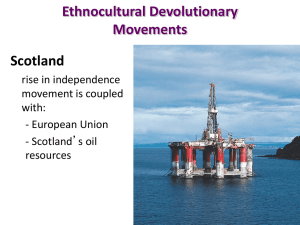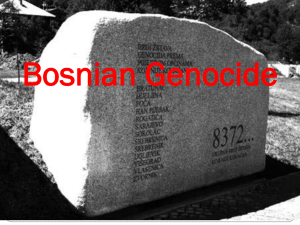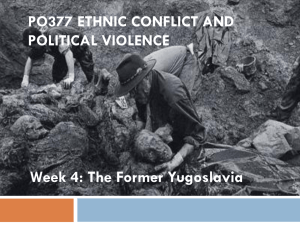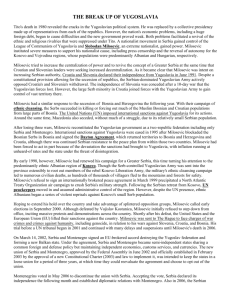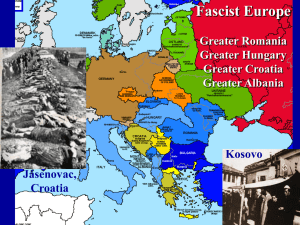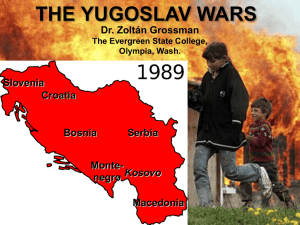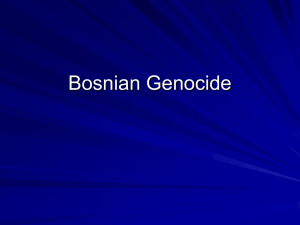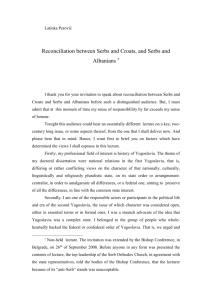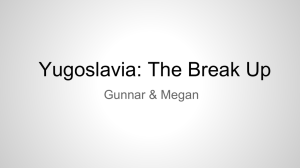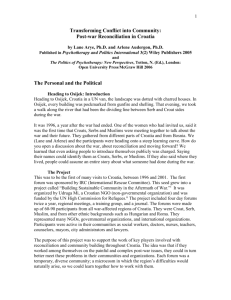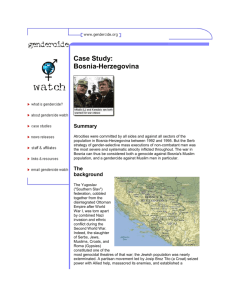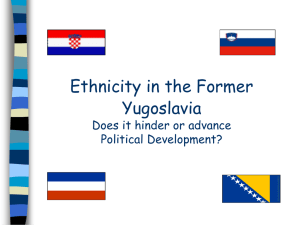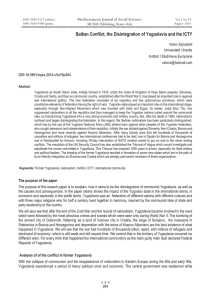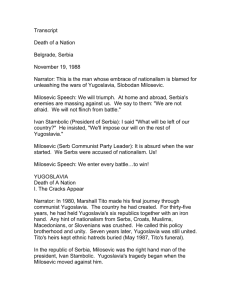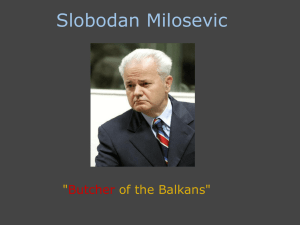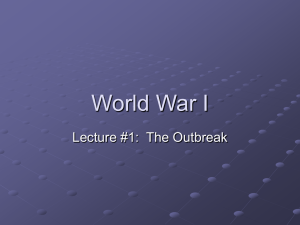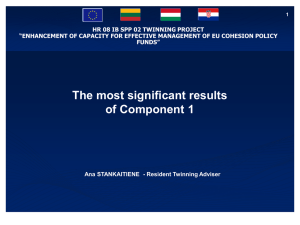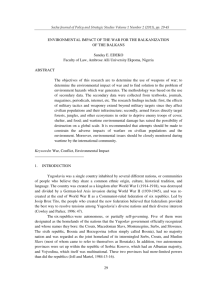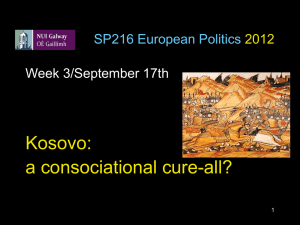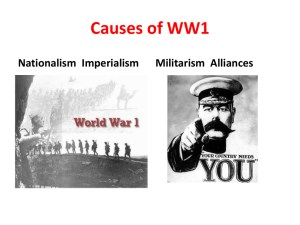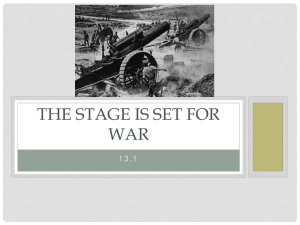Powerpoint slides (Yugoslavia)
advertisement
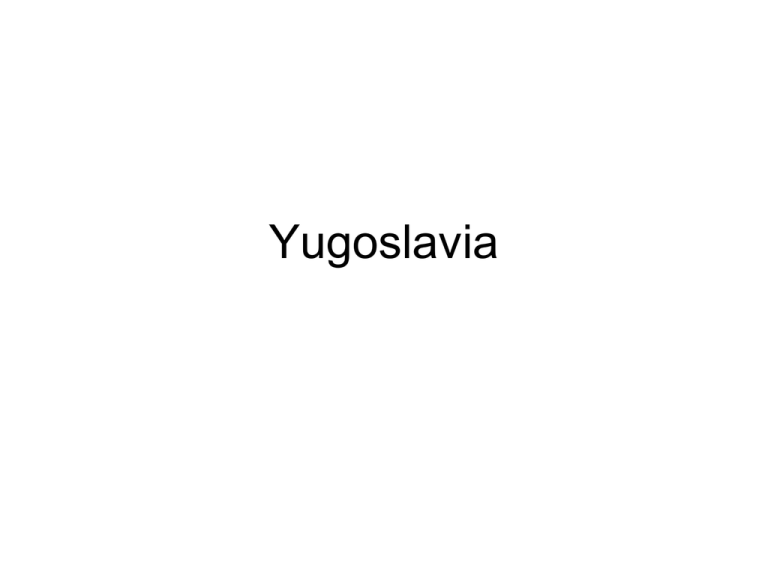
Yugoslavia One view of the war . . . • “It’s really a tragic problem . . . The hatred between all three groups – the Bosnians, the Serbs, and the Croations – is almost unbelievable. It’s almost terrifying, and it’s centuries old. That really is a problem from hell.” - Warren Christopher, Secretary of State under President Clinton Geography and Demographics • 6 republics: Slovenia, Croatia, BosniaHerzegovinia, Serbia, Montenegro, Macedonia • 2 autonomous regions in Serbia: Vojvodina and Kosovo Geography and Demographics • Many ethnic groups: Serbs, Croats, Slovenes, etc. • Serbs largest in country, but not majority • Complications: boundaries of ethnic groups not the same as boundaries of republics! Ancient History • Prior to WWI: Area dominated by AustroHungarian (in NW) and Ottoman (in SE) Empires. • No history of fighting, groups not enemies. • At times, groups cooperated to oppose foreign occupying powers. First Yugoslav State • Formed at the end of WWI. • Marriage of convenience, entered into willingly by all parties. First Yugoslav State • BIG challenges: – Poor, war scars, diversity – Political: what would this new state look like? • Serbs: wanted strong, centralized state to protect Serb minority populations in other regions. • Others: wanted decentralized state to protect against Serb domination. First Yugoslav State • Solution: a strong, centralized state – Serb preferences won out (this time). – Other groups not happy, but try to work together to iron out problems. WWII • Hitler invades Yugoslavia in 1941 – Installs puppet regimes in Serbia and Croatia. • Croat state (Ustasha): cleanse Croatia of Serbs. • Serb paramilitaries (Chetniks) organize and fight Ustasha. – Horrific fighting, bitter memories. Irony: Ustasha not popularly chosen. WWII • Tito and the Partisans – Communists. – Integrating force. – Fought with Allies – Fought civil war against Ustasha and Chetniks – Won, took power at close of WWII Tito’s Yugoslavia • Inherited a tough situation: – Economic devastation – Bitter memories of civil war – Demographic snake pit: what to do about Serbia? Tito’s Yugoslavia • Use the CP as an integrating force. • Promote ideology of growth and development. • Stomp out nationalism. • Not a democracy. Dissent and opposition not tolerated. CP only game in town. • Rely on personal popularity and charisma. Tito’s Yugoslavia • Give republics autonomy over own affairs. • Each republic gets a veto vote in the Federal Presidency. • Make Vojvodina and Kosovo autonomous regions, give them veto votes in the Federal Presidency also. Tito’s Yugoslavia • Consociationalism: – Power-sharing by groups. – Under-represent the largest, over-represent the smallest. – Devolve as much as possible to the subnational level. • Balance and constrain Serb power. Tito’s Yugoslavia • Happy Days: – Country experienced economic growth into the 1970s. – Peace! • But: costs of stifling alternative political voices, vacuum when Tito died. Post-Tito • 1980s: Economic slowdown, population distressed, unhappy. • CP bureaucrats paralyzed by crisis: – What was good for one region was bad for another. – Regions used veto in Federal Presidency to block any policy that hurt them. – Stalemate! Post Tito • Political crisis also: – Serbian leaders unhappy about status of Kosovo and Vojvodina. – Tried to address problem legally, but were blocked by veto power of other republics. – Deadlock! Moves by Serbia • Serb politicians look for way around the deadlock: appeal to Serb grievances in Kosovo. – Kosovo: historical significance to Serbs. – Serbs a minority in Kosovo (largely for economic reasons), felt discriminated against. – Politicians: Serbs are being run out of their homeland! (exaggerated claim, but effective). • Weakened CP doesn’t shut them down. Moves by Serbia • Enter Slobodan Milosevic – 1987: President of Serbia, Ivan Stambolic, sends Milosevic to Kosovo to hear out the complaints of the Kosovo Serbs – Was supposed to stick to CP anti-nationalist line. Moves by Serbia • Instead, took the side of the nationalists. • Famous words, addressing crowd: “You will not be beaten again.” Moves by Serbia • “Rallies for Truth” – Orchestrated by politicians – Demanded end of autonomy of Vijvodina and Kosovo – Dramatized situation of Serbs in Kosovo – Spread from Serbia to other area of Yugoslavia, escalated in tone and demands. • Non-Serb leaders continue to refuse to negotiate with Milosevic. Moves by Serbia • Milosevic topples leaders in Vojvodina, Kosovo, and Montenegro, installs men loyal to him. • Radical effect on balance of power in Yugoslavia: Milosevic now controls 4 out of 8 votes in the Federal Presidency. Response of Slovenia and Croatia • Leaders of Slovenia and Croatia very nervous, set about trying to weaken the federal authority of Yugoslav state. • Slovenia: – Backed Albanian resistance in Kosovo – Refused to allow rally for truth – Pulled out of Yugoslav CP Response of Slovenia and Croatia • Croatia: – At first: try to broker compromise, preserve Yugoslavia – Strategy changed abruptly with election of Franjo Tudjman in May 1990. Response of Slovenia and Croatia • Tudjman and cronies: provocative nationalists. – Checkerboard flag. – Serbs: secondary minority status. – Purged Serbs in local governments – Talked big about taking Croatia out of Yugoslavia. Escalation • Serb minority in Croatia: scared. Fears played up by Serb politicians. • Summer 1990: Serbs in Krajina (area of Croatia) armed themselves and declared self-rule. • Tudjman: formed own paramilitaries Escalation • June 1991: Slovenia and Croatia declare independence. • Serbia lets Slovenia go without fight. Escalation • Not so Croatia. Serbia, plus Yugoslav National Army (JNA), fight to keep it in. • Large-scale war erupts in Croatia. Fighting spread from there to Bosnia. Implications for Ethnicity Theories • Contrary to Primordialism: – The war was not the result of “ancient” hatreds. Conflict between groups was relatively new. – Peace was the norm, not war. If conflict was so inevitable, how did they avoid it for so long? – Why 1990 instead of 1950? • Instrumentalism helps explain timing: the rise of Milosevic and Tudjman. Implications for Ethnicity Theories • But instrumentalism, with its focus on rational cost/benefit calculations, is insufficient. – Why did the people respond? Emotions – anger, fear, distrust, resentment made them receptive. Not “ancient” but no less real. – Also difficult for instrumentalism: the brutality and emotion of the fighting. – Can’t explain a bloody process with a bloodless theory! Implications for Conflict Theories • Yes, grievances existed. • However, they were nothing new. Why did they suddenly flower into conflict? Societal explanations important, but insufficient. Implications for Conflict Theories • Politicians played a critical role: whipped up emotions, initiated conflict. • At national level, change in political leadership important: Tito suppressed nationalism, his successors encouraged it. Implications for Conflict Theories • But also key: the weakness of the Yugoslav state after Tito. – Communist Party: unable to cope with challenges. – Veto power of republics => deadlock. – State unable to contain nationalist politicians, gave them critical window of opportunity.
